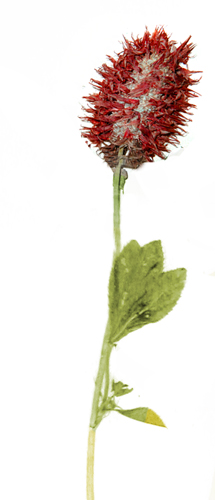Relatives
Trifolium vesiculosum Savi. - Bladdery Clover.
Taxonomic position.
Family Fabaceae Lindl., genus Trifolium L.Synonyms.
Trifolium turgidum Bieb.Morphology and biology.
Annual herbaceous plant. Stems 20-40 cm tall, straight, glabrous, ribbed, often reddish, simple or few-branched. Stipules oblong, their free parts lanceolate-subulate. Leaf blades glabrous, elliptic-lanceolate, those of lower leaves obovate, serrately dentate at margins with sagittate pale spot above. Calyx globosely inflated, about 4 mm long. Racemes dense, oval- or ovoid-oblong, up to 3.5-4 cm long. Corolla pale purple, much longer than calyx. Fruit is a scarious pod with 2-3 seeds. Flowers in June, fruits in July. Self-incompatible, cross-pollinated plant.Distribution.
Caucasus, Moldova, Black Sea Region.Ecology.
In lowland, in meadows, on dry grassy slopes.Economic value.
May be used as forage plant.References:
Galushko AI. 1980. Flora of the North Caucasus: Handbook. V.2. 352 p. (In Russian).Grossheim AA. 1952. Flora of Caucasus. 2nd ed. V.5. P.194-221. (In Russian).
Bobrov EG. 1987. Clover - Trifolium L. In: Fedorov AA., Tzvelev NN., eds. Flora of the European part of the USSR. V.6. P.195-208. (In Russian).
Bobrov EG. 1945. Clover - Trifolium L. In: Shishkin BK., ed. Flora URSS. V.11. P.189-261. (In Russian).


